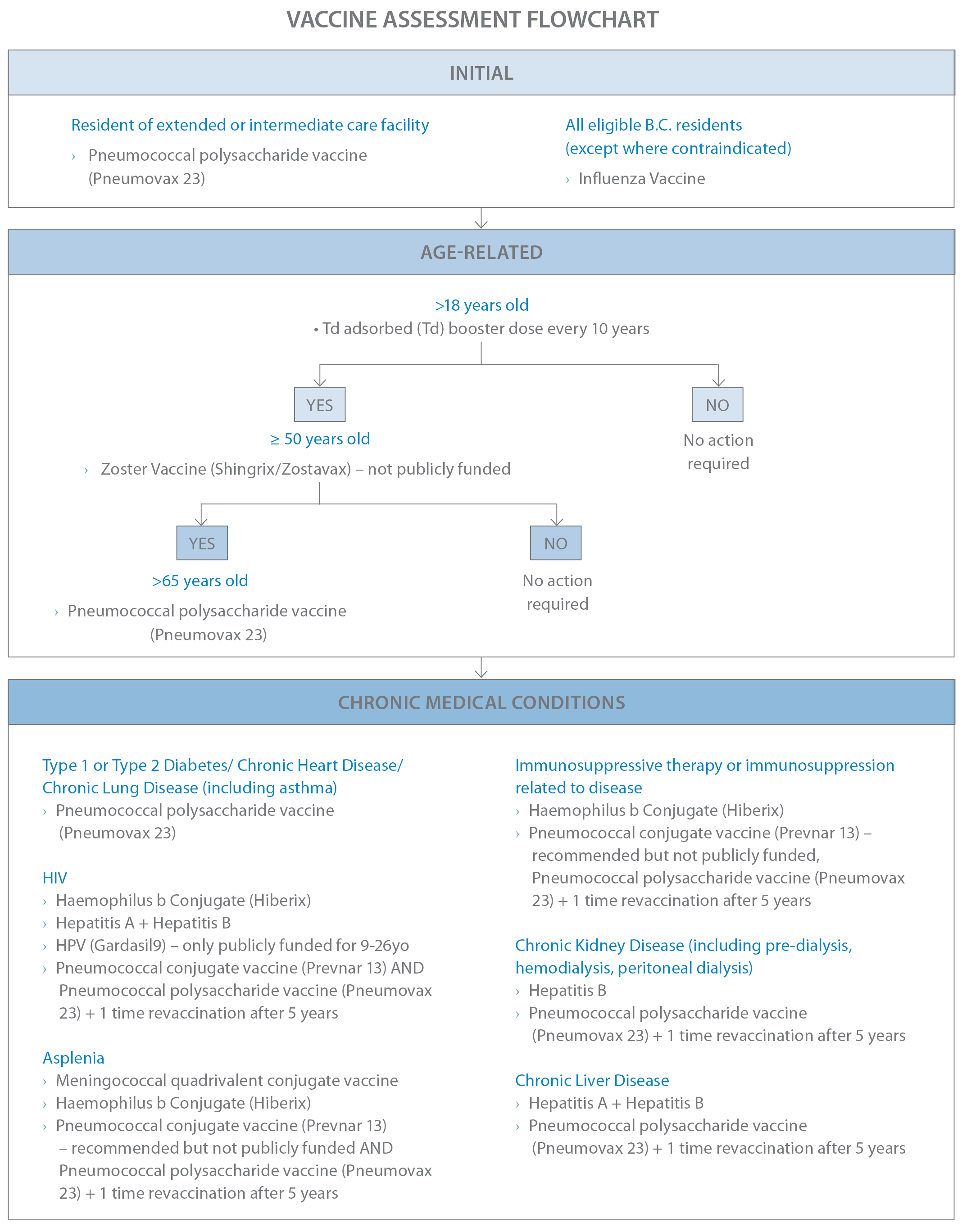
Jillian Reardon, BSc(Pharm), ACPR, PharmD. ORCiD: 0000-0001-7611-5689
Ali Reza Ladak, BSc(Pharm), RPh. ORCiD: 0000-0003-3326-0354
Adrian Ziemczonek, BSc(Pharm), RPh. ORCiD ID: 0000-0002-3656-4954
Annita Giang, BSc(Pharmacology), Student Pharmacist - E2P PharmD Program.
Barbara Gobis, BSc(Pharm), ACPR, MScPhm, PCC. ORCiD: 0000-0003-0174-1137
Faculty of Pharmaceutical Sciences. University of British Columbia. Vancouver BC, Canada
Introduction
Despite efforts by public health agencies and health-care professionals, Canada is not achieving its national immunization coverage goals.1
Prior to the current global COVID-19 pandemic, in the 2018/19 influenza (flu) season, only 43% of adults (aged 18 to 64 years) with high-risk medical conditions and 70% of seniors (aged 65 years and older) received a flu vaccine. This falls short of the national target of immunizing 80% of high-risk individuals.
Similarly, Canada also falls short on the goal of 80% for pneumococcal immunization in seniors (58%) and tetanus immunization in adults (69%).2,3
Results of the 2016 adult National Immunization Coverage Survey indicate that 79% of Canadian adults believe they know enough about the benefits of vaccines and 88% believe they are up-to-date on their vaccinations, despite only 3% reporting they have received the correct number of vaccines for their age/risk group.4 Pharmacists in B.C. are ideally positioned to help provide immunization services to address this gap.
The majority of full registrant pharmacists with the College of Pharmacists of BC have authorization to administer immunizations.5 Pharmacists in B.C. also have the widest access to publicly funded vaccines in Canada, and can claim administration fees from PharmaCare.6 Data from the 2018/19 fiscal year indicates B.C. pharmacies claimed over 750,000 vaccine administration fees for publicly funded vaccines.7 In Canadian jurisdictions where pharmacists are permitted and reimbursed to administer flu vaccines, uptake has increased.8
During the 2017/18 flu season, for the first time, more Canadian adults were immunized at pharmacies (34%) than physician offices (30%). Although Canadians may choose to receive their flu immunization from a pharmacy out of convenience, this is not the sole determining factor. Isenor et al. noted that 50% of immunization recipients in Nova Scotia indicated service was better in the pharmacy compared to other settings and 40% felt it was as good as other settings. Respondents also noted the positive environment, professionalism and knowledge of the pharmacists as appealing.9 In our experience, feedback from patients who have received their influenza immunization from a pharmacist or student pharmacist at our clinic is also overwhelmingly positive.
With the current global pandemic, health-care professionals are being urged to continue providing and prioritizing routine, yet essential, immunization services to avoid increases in vaccine-preventable diseases.10 Members of the public are more likely to get immunized when they are advised to by their health-care provider.11 This is a call to action for all B.C. pharmacists to practice to their full scope by integrating immunization assessments and administration as routine care in their practices.
When to Assess Immunization Status
During routine patient care encounters
- Ask about immunization status when discussing any health matters with a patient.
- Any patient who is not current or does not know their status needs assessment.
- Our team uses a simple algorithm to identify immunization opportunities based on patient age, chronic illness and other risk factors (see Flowchart).
- Whenever possible, administer vaccine(s) at the same time as the assessment to minimize contact time for the patient and pharmacist, and avoid loss to follow-up.
When administering an influenza immunization
- Ask patients about their need for routine immunizations (using the algorithm) when they come in for their flu shot.
- These patients are already accepting of immunizations and, in general, inactivated vaccines can be administered at the same time as other inactivated or live vaccines.

Advance Preparation
Making immunization assessments part of routine care is straightforward with some simple, advanced preparation:
- Mindset – Adopt the mindset that every patient is under-immunized until confirmed otherwise. With COVID-19, patients are more aware of and accepting of immunization and will appreciate you checking that they have recommended protection.
- Include all staff – Any pharmacy staff member can ask patients about immunization status as an initial screening step. If required, the pharmacist can then perform an in-depth assessment.
- Have a point person - Assign a staff-member to maintain vaccines, injection supplies and PPE, and track expiry dates so in-date products are always available. When flu season comes around, this person can order other routine vaccines at the same time.
- Leverage student pharmacists – Most 4th year student pharmacists on practicum are authorized to administer immunizations with supervision. Other students who do not have their authorization can still help with the assessments, screening questions and other support preparations.
- Have vaccine on hand - Maintain a small quantity of routinely requested publicly funded vaccines (Influenza, Td, Pneumococcal Polysaccharide and MMR) at your pharmacy so you can immunize patients opportunistically. If warranted by your patient population, consider maintaining a small quantity of other recommended vaccines that are not publicly funded (e.g. herpes zoster) as well.
- Order doses of other vaccines on a case-by-case basis - When needed, order other publicly funded vaccines as per public health and Pharmacare policies: https://www2.gov.bc.ca/gov/content/health/practitioner-professional-resources/pharmacare/pharmacies/vaccine-resources-for-pharmacists#general-information
Resources
The BC Centre for Disease Control and Immunize BC provide comprehensive resources for assessing patients and determining appropriate candidates for specific vaccines. Practical information such as compatibility of administering multiple vaccines at one time can also be found on these websites.
In Summary
Compared to pharmacists across Canada, BC pharmacists are in the enviable position of having the greatest access to publicly funded vaccines as well as a payment model for immunization services. Due to COVID-19, it is highly likely that more patients will be motivated to be current with their influenza and other vaccinations this fall. With a bit of pre-planning and a process in place, this is the ideal time to make immunization assessments and services part of your routine approach to patient care.
